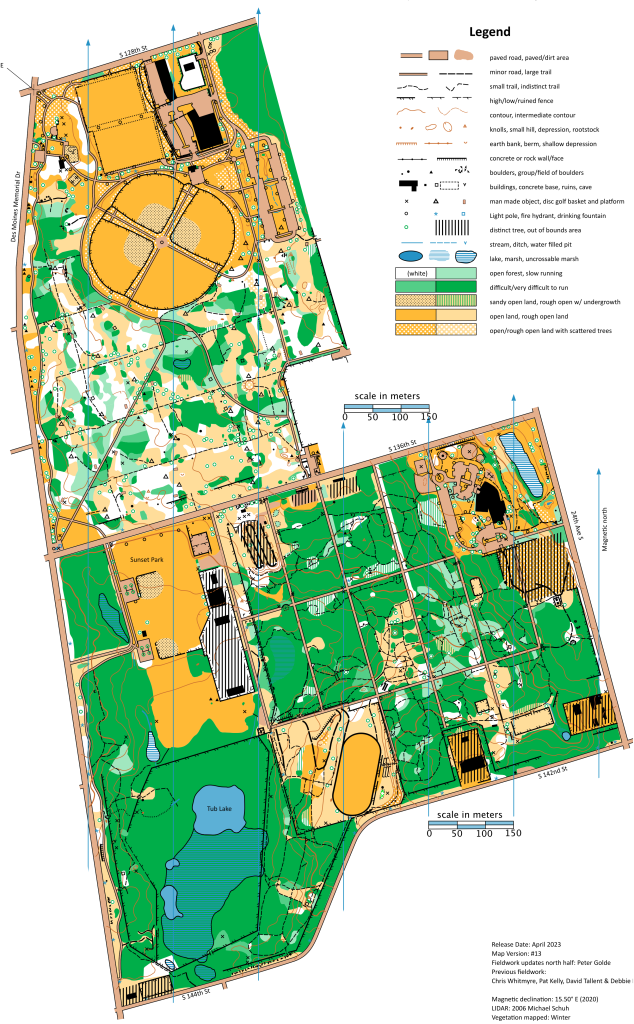WIOL # 2 N. SEATAC Training Opportunities
November 5, 2023 by John Brady
2023-2024 Season WIOL#2 Offered Training Package

Race Prep
Preview previous N. SeaTac events on COC’s Routegadget
Play the video game Running Wild
Each of these links will take you to a computer simulation video game. The simple object is to click on the screen the route you would take to get to each checkpoint. However, if used as a visualization and route tool, you will see it can be much more useful. I challenge you to consider this as you do each of these levels. Do not click just to get it over with quickly, but rather ensure that each thing you click on is a fundamental stepping stone you want to see on or near your path. Don’t be so focused on shortest path either. Get the most out of your training. Do it twice: once with urgency and once with specificity. Then compare! Password for each course is COC
- Beginner: How can you tell if you are facing the same way as your map? How do you know you are going the right way? What big things will you see along the way. What does each color mean and what will it look like in real life? Was there more than one way to get to the control? When I clicked, did I just click the shortest route or did I click on every big stepping stone along the way? Want to learn more about map symbols, go here or here and study up.
- Intermediate: Every symbol you pass, make sure you know what it means. What are things you “might see” vs things you “will see”? Was it possible to work ahead using the 1-2-1 method (1: get the route to next control. 2: Find the next two stepping stones you will be looking for. 1: Peek ahead to the next leg route if time permits to allow you to flow through the following control. Ask yourself as you are doing this, what would I be doing with my map in the actual race? Where would I be confirming with my compass in the actual race? Where could I make a route choice error? Where would I lose 20-30 seconds in real life?
- Advanced: Focus on the little things that kill time. Parks are easy navigationally speaking, but N. Seatac is abound with parallel errors and features that can cause you chaos if you do not have a strategy to deal with them. Even if navigating well, seconds here or there can be lost. Where would you lose time? Where should you control speed and where should you simplify by using things like backstops to allow full speed? Where are the areas of confusion and clarity? What is the feature the control is located on and how might you miss finding the feature when in the control circle. Do the game twice. Really focus on max urgency on the first time, then max safety the second time. Decide what you would do a third time using a combination of the two and then see if you can keep a visual flow of items you expect to see, all while using the confirmation tools appropriate for a course at this level of difficulty (easy). Take what you learned to your route-determination and speed control mindset at the start line. When you are done, use the RW analysis tool to compare to others.
Pre-Race: Day of Meet
- Come by Coaches Corner to play around with some warmup drills or skills. Maps will be provided at the training tent starting by 0930.
- The area for warmup will be quite limited. However, we will try and set up a micro course if there is enough space.
- There is a slight possibility that we will set up compass training for the final time this year at this course (assuming we are allowed to use the soccer fields). If so, you have a few days to buy a good compass and prepare for the training. It takes TONS of practice to become proficient with the compass enough to use it with speed and without thought. The areas of the disc-golf course at N. Seatac are ideal places to shoot a precise bearing and cut across fields. If you plan on doing that, better to practice ahead of time. Thumb compasses can be bought from Rick and Eileen Breseman at the race if you don’t already own one…you just need to find them and ask if there are any available. You can also go to the website All4O to buy supplies, but they ship from overseas and often take a bit of time to arrive. Thumb compasses are far superior to baseplate compasses IMO.
Analysis
About the Route! This is a social conversation meant for all ages.
Dial in, chat, and discuss the course and different routes with 2 experts from COC as you all enjoy talking about the “what-if’s” of orienteering. “What if I just didn’t do something crazy here?”
